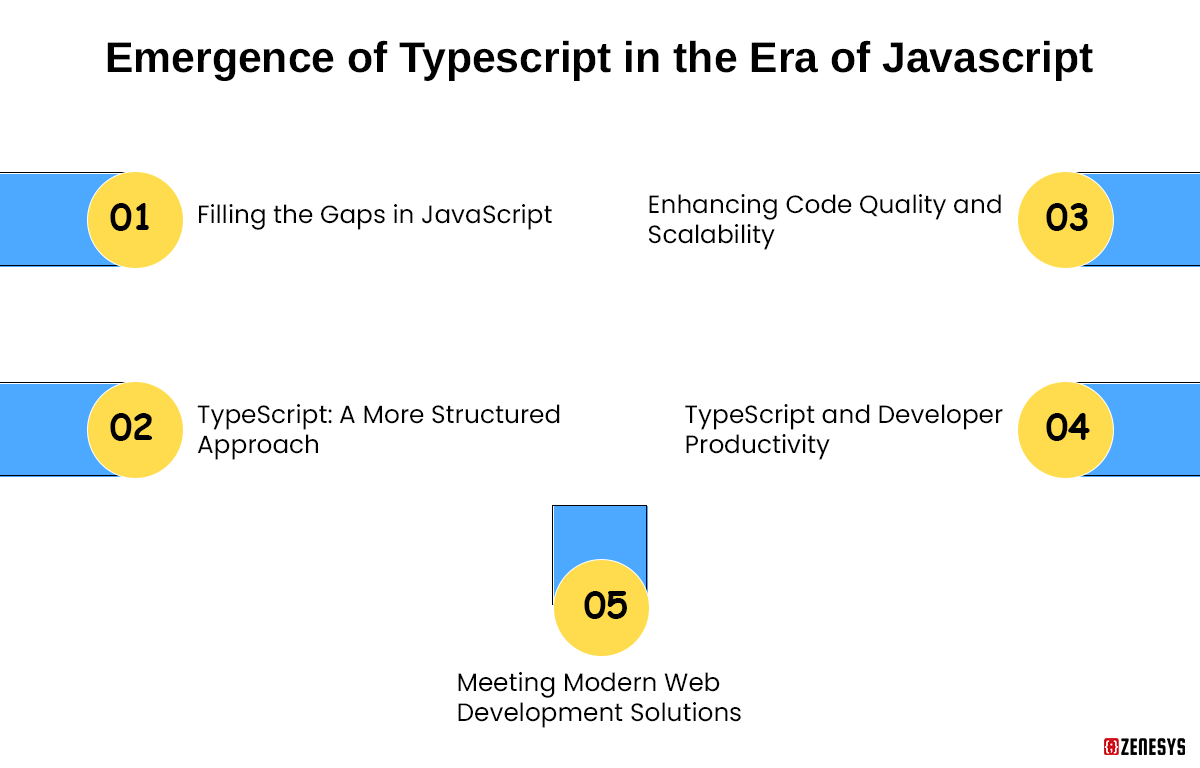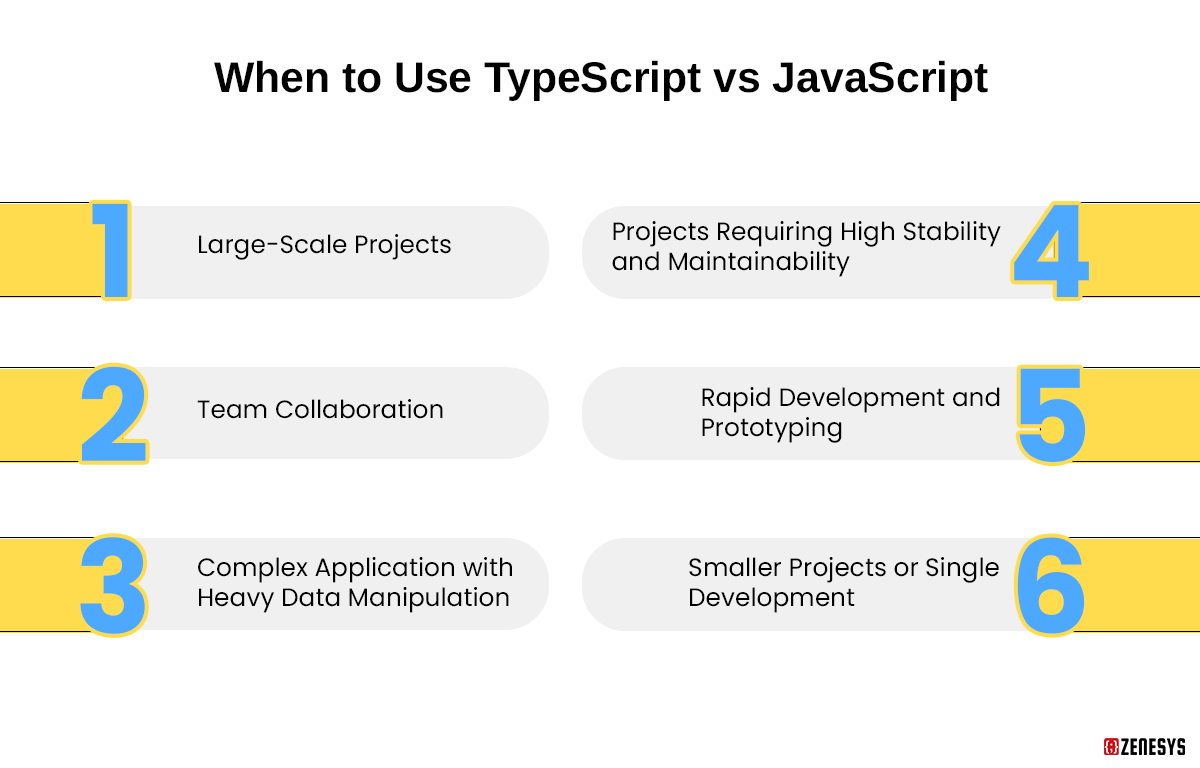JavaScript has been like a classic hit song in the world of web development - versatile, universally loved, and adaptable to various styles. It's the scripting language that brings websites to life, creating interactive and dynamic user experiences. Whether you’re building a small blog or a complex web development solution, JavaScript has been the go-to choice for developers. One of the studies from W3Techs showed, that Javascript is used by 98.8% of all the websites.
TypeScript adds static typing to JavaScript, providing a more structured approach to coding. It is the 20th most popular on the Entire Internet in the JavaScript Library category according to BuiltWith. Leading front-end development companies use Typescript, especially for larger, more complex projects where managing a vast codebase can become a significant challenge.
Emergence of Typescript in the Era of Javascript
Imagine you have a trusty old toolbox. It’s served you well for basic DIY projects, but now you’re tackling something bigger. You realize you need more than just the basic tools. That’s essentially why TypeScript was developed, even though JavaScript was already popular and widely used.

Filling the Gaps in JavaScript
As web development solutions became more complex and larger, developers started facing challenges. They needed tools to manage this complexity efficiently, which is where JavaScript showed its limitations.
TypeScript: A More Structured Approach
TypeScript was created to offer a more structured approach to building applications. It introduced static typing, which means you define the types of variables, functions, and objects right from the start. This is like a detailed blueprint before starting a construction project, reducing the chances of errors and making the whole process smoother and more predictable.
Enhancing Code Quality and Scalability
In large-scale projects, maintaining code quality and ensuring it can be scaled and managed effectively are crucial challenges. TypeScript addresses these issues. With its advanced features, it helps leading front end development companies to write more robust code, which is easier to debug and maintain. It's like upgrading your toolbox with specialized tools, making it easier to handle complex projects.
TypeScript and Developer Productivity
Another reason for TypeScript's development was to boost developer productivity. The enhanced code structure and error detection capabilities mean developers spend less time fixing bugs and more time on actual development. It's like having a more efficient workflow that streamlines the entire development process.
Meeting Modern Web Development Solutions
The web development landscape is always evolving, and TypeScript was developed to meet these changing demands. It offers the flexibility of JavaScript but with added features to tackle the challenges of modern web development solutions, like building large-scale applications or complex front-end frameworks.
Read Also: Tailwind CSS vs. Bootstrap: Who is More Relevant in the Current Scenario
Key Differences - Typescript vs Javascript

Static vs. Dynamic Typing
JavaScript uses dynamic typing, where variable types are determined at runtime. This offers flexibility but can lead to unexpected bugs if the wrong type of data is used. TypeScript uses static typing, meaning you define the type of variables when you write the code. This makes the code more predictable and less prone to runtime errors, which is crucial for maintaining large-scale applications.
Code Complexity and Scale
JavaScript is ideal for smaller projects due to its simplicity and ease of use. TypeScript, with its advanced features like interfaces and generics, is better suited for larger, more complex projects. TypeScript's structure helps manage large codebases more efficiently, making it a go-to for enterprise-level applications.
Error Detection
In JavaScript, most errors are found when the code runs, which can be time-consuming to debug. TypeScript, on the other hand, identifies errors during the code compilation process, before the code runs. This early detection saves valuable time and resources in the leading front-end development companies, enhancing productivity.
Learning Curve and Developer Experience
JavaScript is generally easier to learn due to its widespread use and simpler syntax. TypeScript, while building upon JavaScript, introduces additional concepts like types and decorators, which can have a steeper learning curve. However, this added complexity brings long-term benefits to code manageability, especially for developers working on complex projects.
Compilation Requirement
JavaScript code can be run directly in browsers or Node.js environments as it’s an interpreted language. TypeScript, however, needs to be compiled into JavaScript before it can be executed. This compilation step allows TypeScript to catch errors and enforce types, but it adds an extra step to the development workflow, which is vital for ensuring code reliability in complex applications.
Type Annotations and Type Inference
TypeScript allows for type annotations, where developers can explicitly specify types for variables, function parameters, and return types. This explicit type of declaration enhances code clarity and predictability. JavaScript, lacking this feature, relies on type inference, where the types are assumed based on the assigned values, which can sometimes lead to ambiguity in larger codebases.
Interface and Class Implementation
TypeScript introduces the concept of interfaces, allowing for more structured and organized object-oriented programming. This feature is especially beneficial in large-scale projects where maintaining standard structures across the codebase is essential. JavaScript, primarily prototype-based, doesn’t natively support interfaces, which can limit its organization in complex applications.
Tooling and IDE Support
TypeScript’s tooling support, particularly in Integrated Development Environments (IDEs), is more advanced due to its static typing. But this requires hiring professional front-end development Services as IDEs can offer more intelligent code completion, navigation, and refactoring capabilities with TypeScript. JavaScript, while also well-supported, may not provide as rich an environment for code management, especially in large projects.
Ecosystem Compatibility
TypeScript is designed to be compatible with the existing JavaScript ecosystem. This means it can work with most JavaScript libraries, frameworks, and tools, often requiring only minimal adjustments. JavaScript, being the base language, naturally fits into the web ecosystem but lacks the additional features TypeScript brings, which can be critical for enhancing functionality and developer experience in complex projects.
Advanced Object-Oriented Programming (OOP) Features
TypeScript enhances object-oriented programming by offering advanced features like enums, mixins, and decorators, which are not natively available in JavaScript. These features provide a more robust framework for building complex applications, allowing developers to write cleaner, more modular, and maintainable code. This is particularly beneficial for projects that require a high degree of abstraction and complex architectural patterns.
Enhanced Support for Modern JavaScript Features
TypeScript is designed to support the latest JavaScript features and provides backward compatibility. It allows developers to use the newest JavaScript features while still ensuring the code runs on platforms that only support older versions. This forward compatibility is a significant advantage in maintaining cutting-edge web development solutions, ensuring developers can leverage new technologies without sacrificing compatibility.
Read Also: Upgrading Kentico Xperience 13 to Xperience by Kentico - Expert Reasons
In-Depth Comparison - Typescript vs Javascript
| Features | Javascript | Typescript |
|---|---|---|
| Typing System | Dynamic typing | Static typing with type annotations |
| Error Detection | Runtime error detection | Compile-time error detection |
| Compilation | No compilation required (interpreted language) | Requires compilation to JavaScript |
| Project Scale Suitability | Better for smaller to medium projects | Ideal for large-scale applications |
| Ecosystem Integration | Native integration with web ecosystems | Compatible with JavaScript libraries and frameworks |
| OOP Features | Limited OOP support (prototype-based) | Advanced OOP support (classes, interfaces, enums) |
| Community and Resources | Vast community, extensive resources | Growing community, increasingly comprehensive resources |
| Code Maintenance | Can become challenging in large projects | Facilitates easier maintenance for complex projects |
| Backward Compatibility | Direct support for the latest ECMAScript standards | Supports latest JavaScript features with backward compatibility |
| Use in Frameworks | Widely used in frameworks like React JS development, Vue.js | Increasingly used in enterprise-level frameworks |
When to Use TypeScript and JavaScript
By choosing the right language for the right project, developers can effectively address various business challenges such as reducing development time, ensuring code quality, enhancing collaboration, and maintaining scalability in their web development solutions.

Large-Scale Projects
Use TypeScript for large-scale or enterprise-level applications. Its static typing and advanced OOP features make managing a large codebase more manageable and less error-prone. It's like having a detailed map when navigating a big city, ensuring you can keep track of all the different parts without getting lost.
Team Collaboration
Choose TypeScript when your project involves collaboration among a large team of developers. TypeScript’s clear typing system helps maintain a consistent code structure, making it easier for multiple developers to work on the same project without confusion. It's like speaking a common language in a large group to ensure everyone understands each other clearly.
Complex Application with Heavy Data Manipulation
For web development solutions that involve complex data manipulation and need robust error-checking mechanisms, TypeScript is the better choice. Its ability to catch errors at the compilation stage can save significant debugging time and enhance overall code quality, essential in data-intensive applications.
Projects Requiring High Stability and Maintainability
If your project demands high stability and ease of maintenance in the long run, go with TypeScript. Its strong type system and compatibility with the latest JavaScript features make it ideal for projects where long-term viability and scalability are critical concerns.
Rapid Development and Prototyping
Use JavaScript for projects that require rapid development and prototyping. Its dynamic nature allows for quicker coding and testing, which can be beneficial in scenarios where speed is more critical than type safety or when quickly testing out new ideas.
Smaller Projects or Single Development
For smaller projects or when working alone, JavaScript might be more suitable due to its simplicity and flexibility. It allows for fast development without the added complexity of TypeScript’s type definitions, making it ideal for smaller-scale applications or personal projects.
Read Also: The Expert guide: why Kentico is far better choice than Sitecore?
Conclusion
Many of the latest web development frameworks like Angular development and React JS development officially support TypeScript, making it easy to leverage the strongly typed language for building complex user interfaces. Vue js development 3.0 also has integrated TypeScript support.
JavaScript has the advantage that it can be used across any framework, though adding type safety requires custom build process integrations. Ultimately, if your preferred frameworks have TypeScript capabilities built-in that can accelerate development, it makes sense to take advantage of them.
Frequently Asked Questions
Qus: Should I learn JavaScript or TypeScript?
If you're new to programming, JavaScript is a good starting point. It's widely used and has a lower learning curve.If you're working on large-scale projects or want to write more maintainable code, TypeScript offers significant advantages.
If you prefer a strongly typed language, TypeScript provides static type checking to help catch errors early in the development process.
Qus: Why should I consider using TypeScript over JavaScript?
Improved code quality: Static typing helps prevent common runtime errors and makes code more maintainable.Better tooling: TypeScript's tooling ecosystem offers advanced features like code completion, refactoring, and debugging.
Scalability: TypeScript is well-suited for large-scale projects due to its strong type system and modularity.
Interoperability: TypeScript code can be transpiled into JavaScript, allowing you to use existing JavaScript libraries and frameworks.
Qus: Can I use TypeScript for both front-end and back-end development?
Yes, you can use TypeScript for both front-end and back-end development. Popular frameworks like React, Angular, and Node.js support TypeScript.Using TypeScript consistently across your project can improve code quality and maintainability.
Qus: When should I choose JavaScript over TypeScript?
If you're working on a small-scale project with a simple codebase, JavaScript might be sufficient.If you're not familiar with static typing or prefer a more dynamic language, JavaScript might be a better choice.
However, as project complexity increases, the benefits of TypeScript become more apparent.


.webp?lang=en-US&ext=.webp)

.webp?lang=en-US&ext=.webp)
